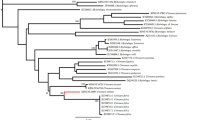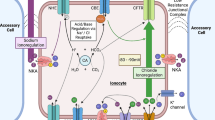Abstract
This work is focused on hemocyanin (Hc) heterogeneity at population level and on the biochemical characterization of the different subunit patterns. Two different approaches have been used: we have characterized Hc subunit composition to describe the subunit polymorphism. Then, we have measured the Hc oxygen-binding affinity to disclose the physiological implications of such heterogeneity. In order to evaluate the intra- and inter-specific variability, different populations of Liocarcinus depurator, Liocarcinus marmoreus, Liocarcinus holsatus, Necora puber (Crustacea: Portunidae), from British Isles and Adriatic Sea, have been sampled. Results indicate that Hc polymorphism normally occurs at both intra- and inter-specific levels and involves the protein subunit type. These evidences extend to the portunid Hc the concept of molecular heterogeneity within species that have been previously reported for other decapod and amphipod crustaceans. Besides, the results support the view that subunit composition of crustacean Hcs is almost species-specific, but also that closely related species share a common pattern. Furthermore, this heterogeneity corresponds to different stability of the native oligomers quaternary structure and different oxygen affinity. The results are discussed in relation with the environmental regimes that characterize the different sampling areas. In addition to Hc, the hemolymph collected in specimens from different sampling areas contained also a non-respiratory pseudo-Hc. This paper reports for the first time the occurrence of pseudo-Hc at the level of population.








Similar content being viewed by others
References
Ballweber P, Markl J, Burmester T (2002) Complete hemocyanin subunit sequences of the hunting spider Cupiennius salei: recent hemocyanin remodeling in entelegyne spiders. J Biol Chem 277:14451–14457
Bellelli A, Giardina G, Corda M, Pellegrini MG, Cau A, Condò SG, Brunori M (1988) Sexual and seasonal variability of lobster hemocyanin. Comp Biochem Physiol A 91:445–449
Brown AC, Terwilliger NB (1998) Ontogeny of hemocyanin function in the dungeness crab Cancer magister: hemolymph modulation of hemocyanin oxygen-binding. J Exp Biol 201:819–826
Burmester T (1999) Identification, molecular cloning and phylogenetic analysis of a non-respiratory pseudo-hemocyanin of Homarus americanus. J Biol Chem 274:13217–13222
Burmester T (2001) Molecular evolution of the arthropod hemocyanin superfamily. Mol Biol Evol 18:184–195
Burmester T (2002) Origin and evolution of arthropod hemocyanins and related proteins. J Comp Physiol B 172:95–107
Burmester T (2004) Evolutionary history and diversity of arthropod hemocyanins. Micron 35:121–122
Callicott KA, Mangum CP (1993) Phenotypic variation and lability of the subunit composition of the hemocyanin of Uca pugilator. J Exp Mar Biol Ecol 165:143–159
Dainese E, Di Muro P, Beltramini M, Salvato B, Decker H (1998) Subunits composition and allosteric control in Carcinus aestuarii hemocyanin. Eur J Biochem 256:350–358
Decker H, Föll R (2000) Temperature adaptation influences the aggregation state of hemocyanin from Astacus leptodactylus. Comp Biochem Physiol A 127:147–154
Decker H, Terwilliger NB (2000) Cops and robbers: putative evolution of copper oxygen-binding proteins. J Exp Biol 203:1777–1782
Durstewitz G, Terwilliger NB (1997) Developmental changes in hemocyanin expression in the Dungeness crab, Cancer magister. J Biol Chem 272:4347–4350
Ellerton HD, Ellerton NF, Robinson HA (1983) Hemocyanin—a current perspective. Prog Biophys Mol Biol 41:143–248
Fling SP, Gregerson DS (1986) Peptide and protein molecular weight determination by electrophoresis using a high-molarity Tris buffer system without urea. Anal Biochem 155:83–88
Froglia C, Manning RB (2006) Marine decapod and Stomatopod Crustacea from Sicily and surrounding seas. Quad Ist Ric Pesca Marittima, Ancona (in press)
Hodgson E, Spicer JI (2001) Subunit compositions of crustacean haemocyanins are species-specific: evidence from non-decapod species. Comp Biochem Physiol 128A:873–888
van Holde KE, Miller KI, Decker H (2001) Hemocyanins and invertebrate evolution. J Biol Chem 276:15563–15566
Immesberger I, Burmester T (2004) Phenoloxidase-like proteins of the tunicate Ciona intestinalis and the origin of the arthropod hemocyanin superfamily. J Comp Physiol B 174:169–180
Ingle RW (1996) Shallow-water crabs. In: Barnes RSK, Crothers JH (eds) Synopses of the British fauna (new series). Linnean Society, London, p 243
Jaenicke E, Decker H (2004) Functional changes in the family of type 3 copper proteins during evolution. Chembiochem 5:163–169
Kusche K, Burmester T (2001) Diplopod hemocyanin sequence and the phylogenetic position of the Myriapoda. Mol Biol Evol 18:1566–1573
Mangum CP (1990) Inducible O2 carriers in the crustaceans. In: Truchot JP, Lalou B (eds) Animal nutrition and transport processes. 2. Transport, respiration and excretion: comparative and environmental aspects. Karger, Basel, Switzerland, pp 92–103
Mangum CP (1993) Structural and functional polymorphism of the haemocyanin O2 transport system of the sand fiddler crab Uca pugilator. J Exp Mar Biol Ecol 165:133–141
Mangum CP (1994) Subunit composition of hemocyanin of Callinectes sapidus: phenotypes from naturally hypoxic waters and isolated oligomers. Comp Biochem Physiol B 108:537–541
Mangum CP (1996) Subunit composition of polymorphic hemocyanin in the decapod crustaceans: differences between sibling species. Physiol Zool 69:568–585
Mangum CP, Greaves J (1996) Hemocyanins of the genus Uca: structural polymorphisms and native oligomers. J Exp Mar Biol Ecol 199:1–15
Mangum CP, McKenney AL (1996) Subunit composition of the crustacean hemocyanins: divergence in incipient speciation. Biol Bull 191:33–41
Mangum CP, Rainer JS (1988) The relationship between subunit composition and oxygen binding of blue crab hemocyanin. Biol Bull 174:77–82
Mangum CP, Greaves J, Rainer JS (1991) Oligomer composition and oxygen binding of the blue crab Callinectes sapidus. Biol Bull 181:453–458
Mantovani M, Scali V, Froglia C (1992) Allozymic characterization and phyletic relationships among four species of the genus Liocarcinus STIPSON 1871 (Crustacea Decapoda). Zool Anz 229:237–247
Markl J (1986) Evolution and function of structurally diverse subunits in the respiratory protein hemocyanin from artropods. Biol Bull 171:90–115
Markl J, Decker H (1992) Molecular structure of the arthropod hemocyanins. In: Mangum CP (ed) Blood and tissue oxygen carriers, Adv Comp Environ Physiol 13. Springer, Berlin Heidelberg New York, pp 325–376
Markl J, Hofer A, Bauer G, Markl A, Kempter B, Brenzinger M, Linzen B (1979) Subunit heterogeneity in arthropod hemocyanin: II. Crustacea. J Comp Physiol 133:167–175
Molon A, Di Muro P, Bubacco L, Vasilyev V, Salvato B, Beltramini M, Conze W, Hellmann N, Decker H (2000) Molecular heterogeneity of the hemocyanin isolated from the king crab Paralithodes camtschaticae. Eur J Biochem 267:7046–7057
Passamonti M, Mantovani M, Scali V, Froglia C (1996/1997) Genetic differentiation of European species of Liocarcinus (Crustacea: Portunidae): a gene–enzyme study. Zool Anz 235:157–164
Rainer J, Mangum CP, Godette G (1985) Subunit heterogeneity of the blue crab (Callinectes sapidus) hemocyanin along a salinity gradient. Am Zool 25:47A
Reese JE, Mangum CP (1994) Subunit composition and O2 binding of the crustacean hemocyanins: interspecific relationships. Biol Bull 187:385–397
Schmitt J (2002) The influence of vertical zonation: differences in hemocyanin structure and function between two crab congeners. M.S. thesis, University of Oregon
Šimunović A (1999) Quantitative and qualitative investigations of the benthic communities in the areas of mobile bottoms of the Adriatic Sea. Acta Adriatica 38:77–197
Spicer JI, Baden SP (2001) Environmental hypoxia and haemocyanin between-individual variability in Norway lobsters Nephrops norvegicus (L.). Mar Biol 139:727–734
Spicer JI, Hodgson E (2003a) Between-population variation in haemocyanin subunit composition of the beachflea Orchestia gammarellus (Crustacea: Amphipoda). J Mar Biol Assoc UK 83:945–947
Spicer JI, Hodgson E (2003b) Structural basis for salinity-induced alteration in oxygen binding by haemocyanin from the estuarine amphipod Chaetogammarus marinus (L.). Physiol Biochem Zool 76:843–849
Sullivan B, Bonaventura J, Bonaventura C (1974) Functional differences in the multiple hemocyanins of the horseshoe crab, Limulus polyphemus L. Proc Natl Acad Sci USA 71:2558–2562
Terwilliger NB (1982) Effect of subunit composition on the quaternary structure of isopod (Ligia pallasii) hemocyanin. Biochemistry 21:2579–2586
Terwilliger NB (1998) Functional adaptations of oxygen-transport proteins. J Exp Biol 201:1085–1098
Terwilliger NB, Dumler K (2001) Ontogeny of decapod crustacean hemocyanin: effects of temperature and nutrition. J Exp Biol 204:1013–1020
Terwilliger NB, Terwilliger RC, Applestein M, Bonaventura C, Bonaventura J (1979) Subunit structure and oxygen binding by hemocyanin of the isopod Ligia exotica. Biochemistry 18:102–108
Terwilliger NB, Dangott L, Ryan M (1999) Cryptocyanin, a crustacean molting protein: evolutionary link with arthropod hemocyanins and insect hexamerins. Proc Natl Acad Sci USA 96:2013–2018
Trentini M, Corni MG, Froglia C (1989) The Chromosomes of Liocarcinus vernalis (Risso, 1916) and Liocarcinus depurator (L., 1758) (Decapoda, Brachiura, Portunidae). Biol Zent Bl 108:163–166
Trentini M, Corni MG, Froglia C (1992) The chromosomes of Carcinus mediterraneus Czerniavsky, 1884, Liocarcinus maculatus (Risso, 1827) and Necora puber (L., 1767) (Decapoda, Brachyura, Portunidae). Zool Anz 228:39–44
Acknowledgments
The authors wish to thank Prof T. Burmester (University of Hamburg) for his suggestions and criticism, Dr O. Marin (University of Padova) for the availability of sequencing facilities. Prof M.J. Kaiser (School of Ocean Sciences, University of Wales, head of the CREAM group) and Dr R. Ormond (University Marine Biological Station of Millport) for providing all the facilities for sampling and Dr M. Bergmann and Dr J. Hall-Spencer for their collaboration in arranging field work. Furthermore, the scientific staff of the CREAM group (Coastal Research Ecology And Management Group), the crews of R/V Prince Madog and Aora and T. Andersen, A. Candeias, E. Chatzinikolaou, C. Saurel, P. Leontarakis, F. Van Gent, fully collaborated during sampling.
Author information
Authors and Affiliations
Corresponding author
Additional information
Communicated by R. Cattaneo-Vietti, Genova.
Declaration: All the experiments comply with the current laws of Italy.
Rights and permissions
About this article
Cite this article
Giomi, F., Raicevich, S., Ferrarese, A. et al. Structural and functional heterogeneity of hemocyanin: intra- and inter-specific comparison in four species of portunid crabs (Crustacea: Portunidae). Mar Biol 151, 1237–1247 (2007). https://doi.org/10.1007/s00227-006-0537-4
Received:
Accepted:
Published:
Issue Date:
DOI: https://doi.org/10.1007/s00227-006-0537-4




